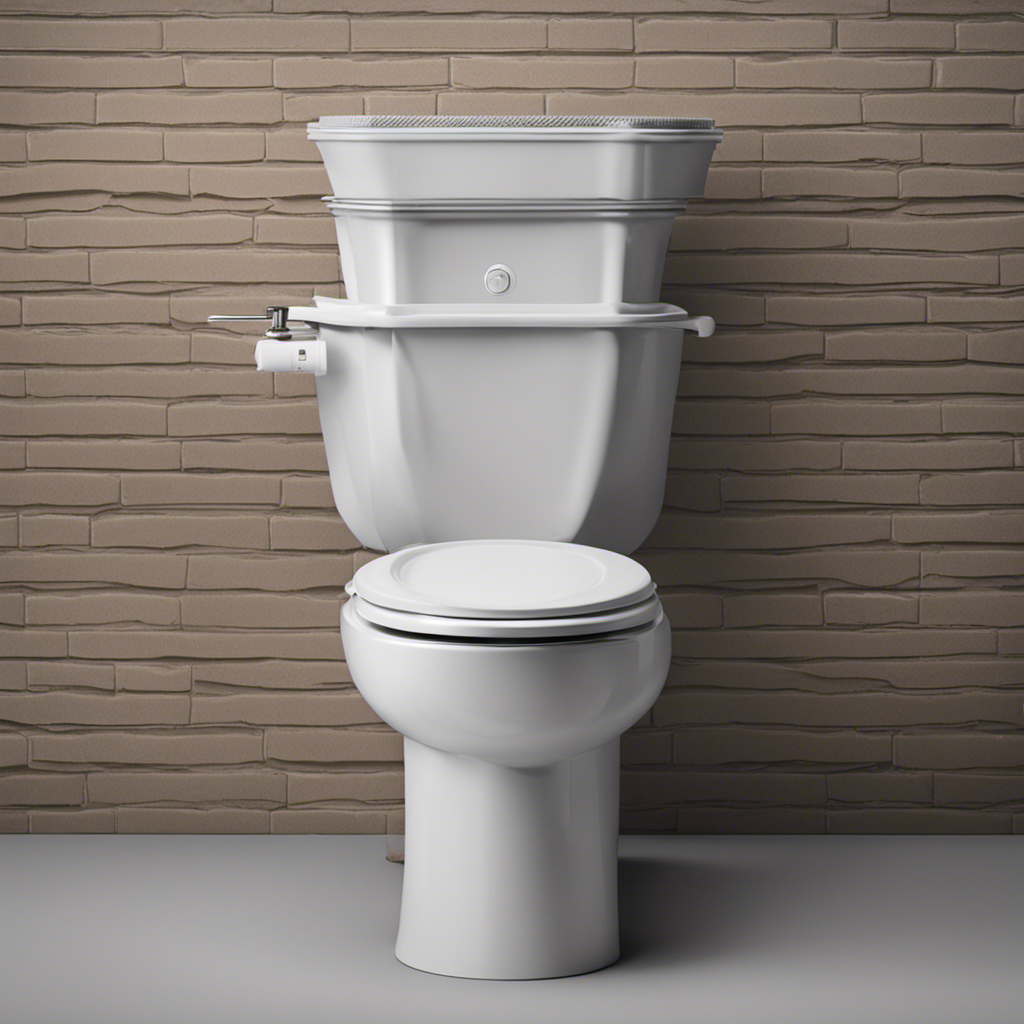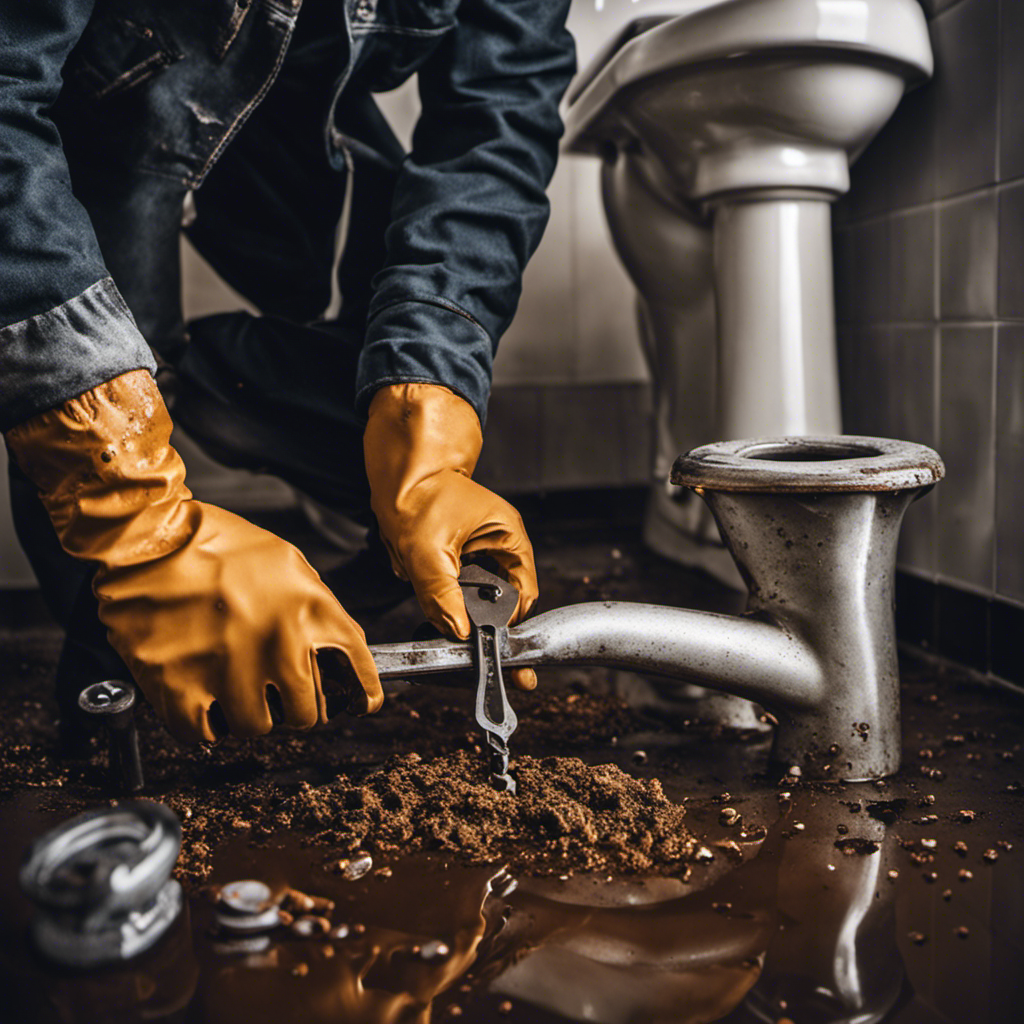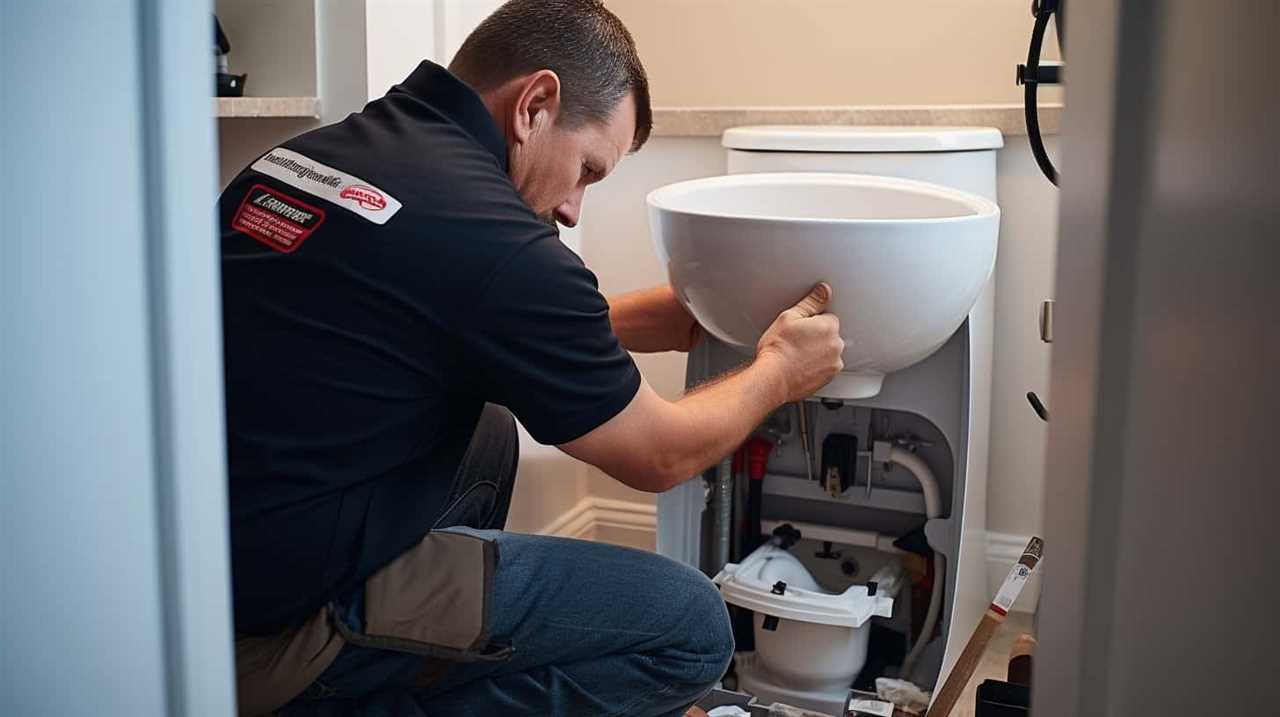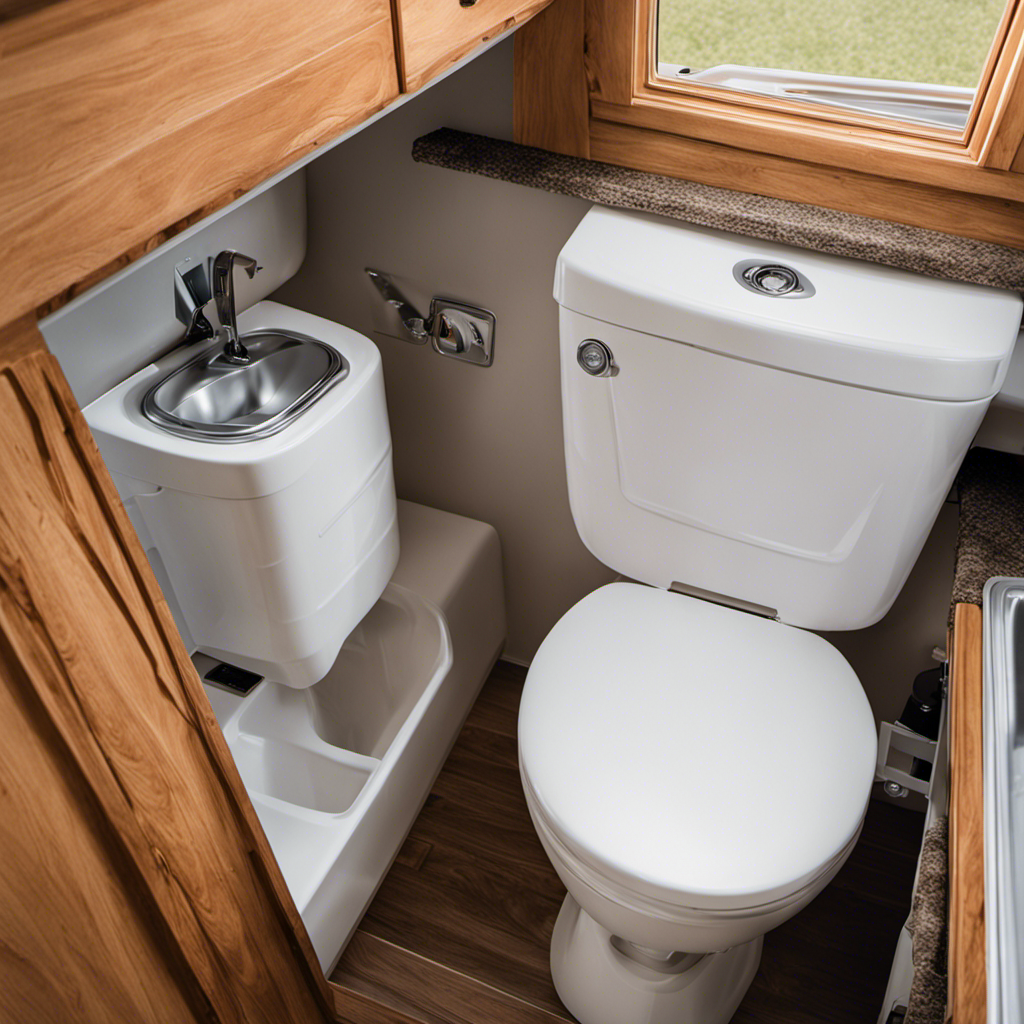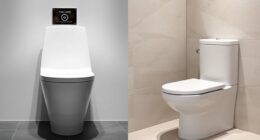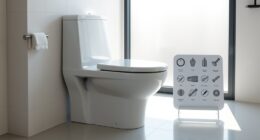I’ve always wondered how a toilet plunger actually works. It seems like a simple tool, but there’s more to it than meets the eye. In this article, we’ll delve into the anatomy of a toilet plunger and uncover the secrets behind its suction power.
I’ll also provide a step-by-step guide on how to use a toilet plunger effectively, explore different types of plungers and how they work, and share some tips and tricks for maximum effectiveness.
Let’s dive in and uncover the mysteries of the toilet plunger together.
Key Takeaways
- A toilet plunger creates suction by forming a tight seal against the drain.
- Pushing and pulling the plunger creates a vacuum effect that generates suction.
- Maintaining a proper seal around the drain is crucial for maximum suction power.
- Different types of plungers are available, each designed for specific types of clogs.
The Anatomy of a Toilet Plunger
A toilet plunger works by creating suction to unclog the toilet. Maintaining a toilet plunger is essential to ensure its effectiveness. After each use, it is important to clean the plunger thoroughly with warm soapy water to remove any residue. Additionally, inspect the rubber cup for any cracks or damage. If there are any issues, consider replacing the plunger to maintain optimal performance.
There are common mistakes that people make when using toilet plungers. One mistake is not creating a proper seal around the drain. To achieve maximum suction, press the plunger firmly against the drain hole, ensuring a tight seal. Another mistake is being too forceful with the plunging action. Instead, use gentle and controlled movements to avoid splashing water or damaging the plumbing.
Understanding the Suction Power
To understand the suction power, you need to know how the rubber cup creates a seal against the drain. When you press the plunger against the toilet bowl, the rubber cup forms a tight seal, preventing air from escaping. As a result, when you push and pull the plunger, it creates a vacuum effect that generates suction. This suction force is what helps to dislodge clogs in the drain.
Let’s explore the science behind toilet plungers by comparing suction and pressure. In simple terms, suction is the force that pulls objects toward each other, while pressure is the force that pushes objects apart. When using a plunger, the suction created by the rubber cup helps to draw the clog out of the drain.
To avoid common mistakes when using a toilet plunger, it is important to ensure a proper seal between the rubber cup and the drain. Make sure the cup is completely covering the drain opening and that there is no air leakage. Additionally, use a steady and controlled motion when plunging to maximize the suction power.
Now that we understand the suction power of a toilet plunger, let’s move on to a step-by-step guide to using one effectively.
Step-by-Step Guide to Using a Toilet Plunger
First, make sure you have a good seal between the rubber cup and the drain to maximize the suction power. This is crucial for effective plunging.
Now, let me guide you through the step-by-step process of using a toilet plunger correctly.
-
Position the plunger: Place the cup directly over the drain hole, ensuring a tight seal.
-
Push and pull: Apply downward pressure on the plunger’s handle to push air into the drain. Then, quickly pull back to create suction and dislodge the clog.
-
Repeat if necessary: If the water level doesn’t recede, repeat the process several times until the blockage is cleared.
Toilet plunger maintenance is essential for longevity and optimal performance. Avoid these common mistakes while using a plunger:
-
Using excessive force: Plunging too forcefully can damage the drain or toilet bowl.
-
Improper technique: Push and pull in a straight vertical motion, rather than at an angle, to maximize suction.
-
Neglecting cleanliness: After use, clean the plunger thoroughly with hot water and disinfectant to prevent the spread of bacteria.
Now that you know how to use a plunger correctly and the importance of maintenance, let’s explore the different types of toilet plungers and how they work.
Different Types of Toilet Plungers and How They Work
Now, let me explain the various types of plungers available and how each one is used. When it comes to unclogging toilets, having the right plunger can make all the difference. Plungers come in different shapes and sizes, each designed for specific types of clogs. Here is a comparison of the materials commonly used in plungers:
| Plunger Material | Advantages | Disadvantages |
|---|---|---|
| Rubber | Flexible, creates a tight seal | Can deteriorate over time |
| Plastic | Durable, resistant to chemicals | May not create a strong seal |
| Accordion-style | Flexible, can reach deep into pipes | Requires more effort to plunge |
Now, let’s talk about plunging techniques for stubborn clogs. If you’re dealing with a tough clog, try these tips:
- Use a plunger with a flange or funnel-shaped extension to create a better seal.
- Apply firm, downward pressure while plunging to force water through the pipes.
- Repeat the plunging motion several times, alternating between quick, forceful plunges and slower, gentler ones.
Tips and Tricks for Effective Toilet Plunger Usage
If you’re struggling with a stubborn clog, try using a plunger with a flange or funnel-shaped extension to create a better seal. This will allow for more effective plunging action and increase the chances of dislodging the clog.
To ensure optimal performance and longevity of your toilet plunger, it is important to properly maintain it. Here are some tips for toilet plunger maintenance:
- Clean the plunger after each use to prevent the buildup of bacteria and germs.
- Inspect the rubber suction cup for any signs of wear or damage. Replace if necessary.
- Store the plunger in a dry and clean place to prevent the growth of mold or mildew.
If you’re experiencing common toilet plunger issues, such as lack of suction or water not draining properly, here are some troubleshooting steps you can take:
- Check if the plunger is creating a tight seal around the drain. Adjust the position if needed.
- Ensure there is enough water in the toilet bowl for the plunger to work effectively.
- Try using a different plunger or a specialized toilet auger if the issue persists.
Frequently Asked Questions
Can a Toilet Plunger Be Used for Sinks or Other Drains?
Yes, a toilet plunger can be used to unclog sinks and other drains. When choosing the right plunger, make sure it has a flat bottom to create a strong seal and a sturdy handle for effective plunging.
How Do I Clean and Maintain a Toilet Plunger?
To clean and maintain a toilet plunger, I recommend using hot soapy water and a brush to remove any debris. After cleaning, make sure to dry it thoroughly before storing it in a clean, dry place. Regular maintenance will ensure its effectiveness.
What Should I Do if the Toilet Plunger Is Not Unclogging the Toilet?
If the toilet plunger is not unclogging the toilet, I can try using alternative methods such as a drain snake or a baking soda and vinegar mixture. If all else fails, I should consider calling professional unclogging services.
Can a Toilet Plunger Damage the Toilet or Plumbing System?
Using a toilet plunger incorrectly can cause damage to the toilet or plumbing system. It’s important to follow proper safety precautions and techniques to avoid potential risks and ensure effective unclogging.
Are There Any Alternative Methods to Unclog a Toilet Without Using a Plunger?
There are alternative methods to unclog a toilet without using a plunger. Some natural DIY toilet unclogging methods include using hot water, baking soda and vinegar, or a toilet auger. These can be effective in preventing toilet clogs.
Conclusion
In conclusion, using a toilet plunger is a straightforward process that anyone can master. By understanding the anatomy of a toilet plunger and how it creates suction power, one can effectively clear a clogged toilet.
Remember to choose the right type of plunger for your specific needs, whether it’s a cup plunger or a flange plunger. And always follow the step-by-step guide for proper usage.
As the saying goes, ‘Where there’s a will, there’s a way.’ So don’t let a clogged toilet dampen your spirit, grab that plunger and get the job done!
